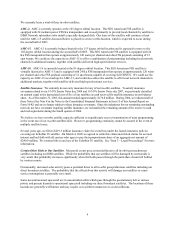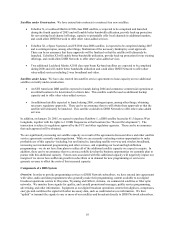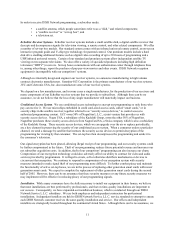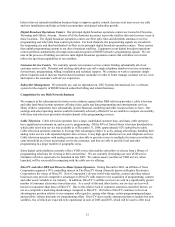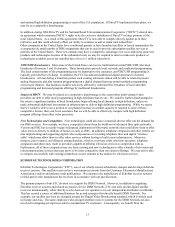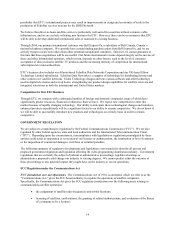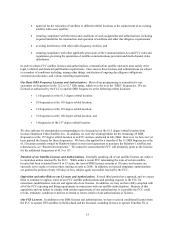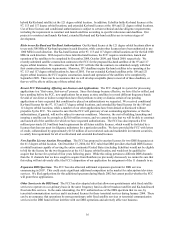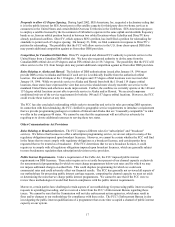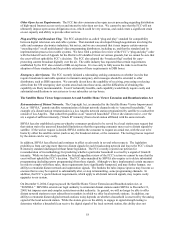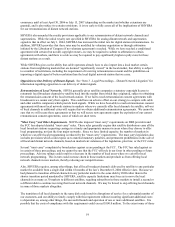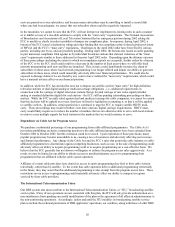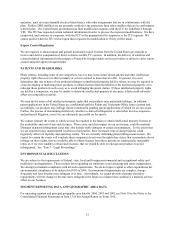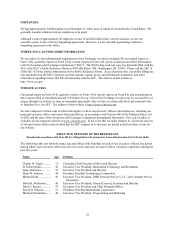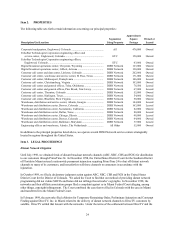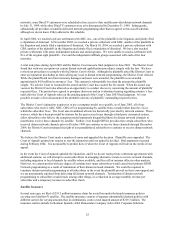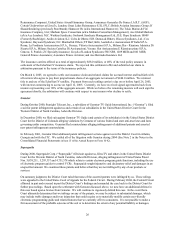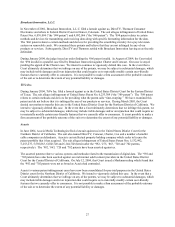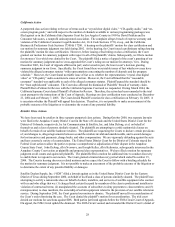Dish Network 2004 Annual Report Download - page 27
Download and view the complete annual report
Please find page 27 of the 2004 Dish Network annual report below. You can navigate through the pages in the report by either clicking on the pages listed below, or by using the keyword search tool below to find specific information within the annual report.19
commence until at least April 30, 2006 or July 15, 2007 (depending on the market and whether extensions are
granted), and is also subject to certain restrictions. It is too early to fully assess all of the implications of SHVERA
for our retransmissions of distant network stations.
SHVERA also amended the royalty provisions applicable to our retransmission of distant network channels and
superstations. While the initial royalty rate specified in SHVERA for analog distant network and superstation
signals is that in effect on July 1, 2004, SHVERA has increased the initial rate for digital station retransmissions. In
addition, SHVERA provides that these rates may be modified by voluntary negotiation or through arbitration
initiated by the Librarian of Congress if no voluntary agreement is reached. While we have reached a conditional
agreement with certain (but not all) copyright owners, we may be required to submit to arbitration to obtain
agreements with others, and there is a risk we may be required to pay significantly higher royalty rates for these
distant stations as a result.
While SHVERA gives us the ability that cable operators already have to also import into a local market certain
stations from neighboring markets that are deemed “significantly viewed” in the local market, that ability is subject
to a number of restrictions, including the requirement of receiving retransmission consent and the prohibition on
importing a digital signal of better resolution than the local digital network station that we carry.
Opposition to Our Delivery of Distant Signals. See “Item 3 - Legal Proceedings – Distant Network Litigation” for
information regarding opposition to our delivery of distant signals.
Retransmission of Local Networks. SHVIA generally gives satellite companies a statutory copyright license to
retransmit local broadcast channels by satellite back into the market from which they originated, subject to obtaining
the retransmission consent of the local network station. If we fail to reach retransmission consent agreements with
broadcasters we cannot carry their signals. This could have an adverse effect on our strategy to compete with cable
and other satellite companies which provide local signals. While we have been able to reach retransmission consent
agreements with most local network stations in markets where we currently offer local channels by satellite, roll-out
of local channels in additional cities will require that we obtain additional retransmission agreements. We cannot be
sure that we will secure these agreements or that we will secure new agreements upon the expiration of our current
retransmission consent agreements, some of which are short term.
“Must Carry” and Other Requirements. SHVIA also imposed “must carry” requirements on DBS providers and
the FCC has adopted detailed “must carry” rules. These rules generally require that satellite distributors carry all the
local broadcast stations requesting carriage in a timely and appropriate manner in areas where they choose to offer
local programming, not just the four major networks. Since we have limited capacity, the number of markets in
which we can offer local programming is reduced by the “must carry” requirements. The must carry legislation also
includes provisions which could expose us to material monetary penalties, and permanent prohibitions on the sale of
all local and distant network channels, based on inadvertent violations of the legislation, prior law, or the FCC rules.
Several “must carry” complaints by broadcasters against us are pending at the FCC. The FCC has ruled against us
in certain of these proceedings, and we cannot be sure that the FCC will rule in our favor in other pending or future
proceedings. Adverse rulings could result in a decrease in the number of local areas where we can offer local
network programming. This in turn could increase churn in those markets and preclude us from offering local
network channels in new markets, thereby reducing our competitiveness.
Also, SHVERA requires, among other things, that all local broadcast channels delivered by satellite to any particular
market be available from a single dish within 18 months of the law’s December 8, 2004 effective date. Because we
had planned to transition all local channels in any particular market to the same dish by 2008 rather than in the
shorter transition period mandated by SHVERA, satellite capacity limitations may force us to move the local
channels in as many as 30 markets to different satellites, requiring subscribers in those markets to install a second or
a different dish to continue receiving their local network channels. We may be forced to stop offering local channels
in some of those markets altogether.
The transition of all local channels to the same dish could result in disruptions of service for a substantial number of
our customers, and our ability to timely comply with this requirement without incurring significant additional costs
is dependent on, among other things, the successful launch and operation of one or more additional satellites. It is
possible that the costs of compliance with this requirement could exceed $100.0 million. To the extent some of those


